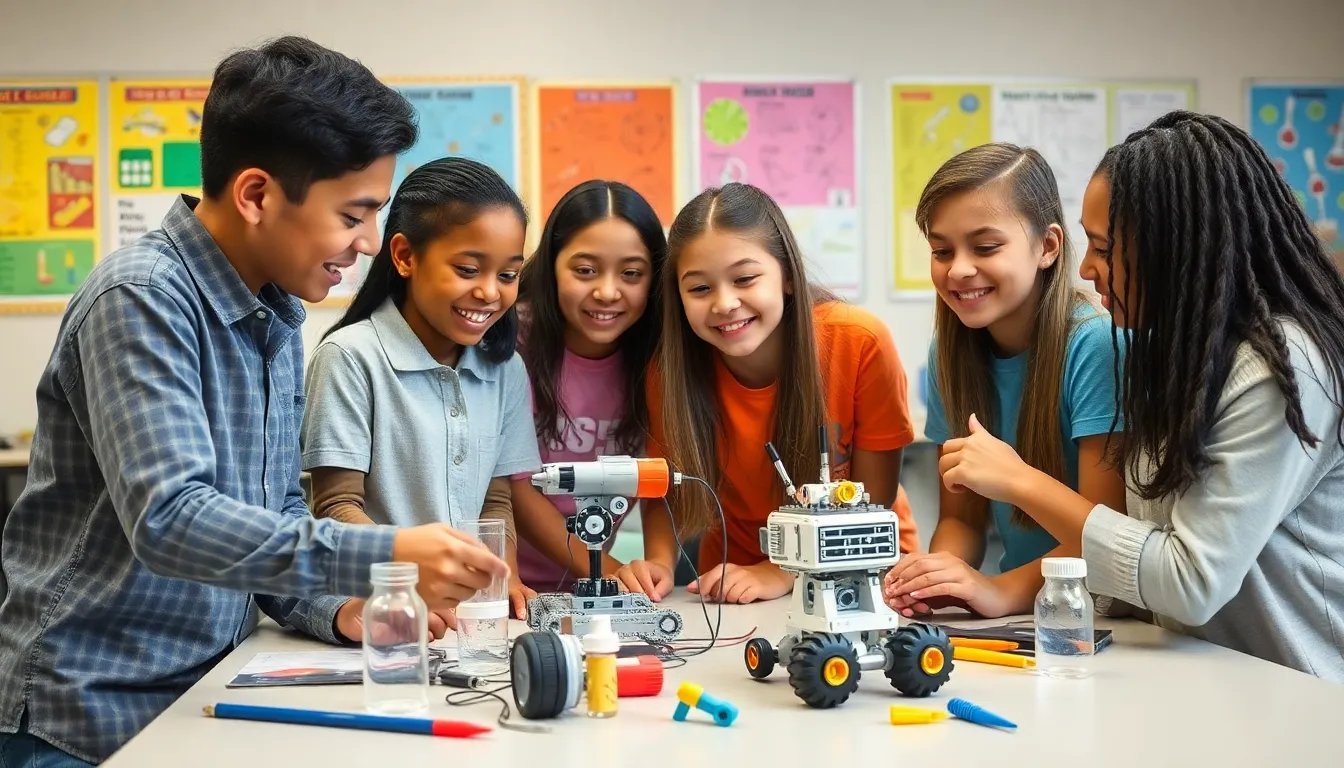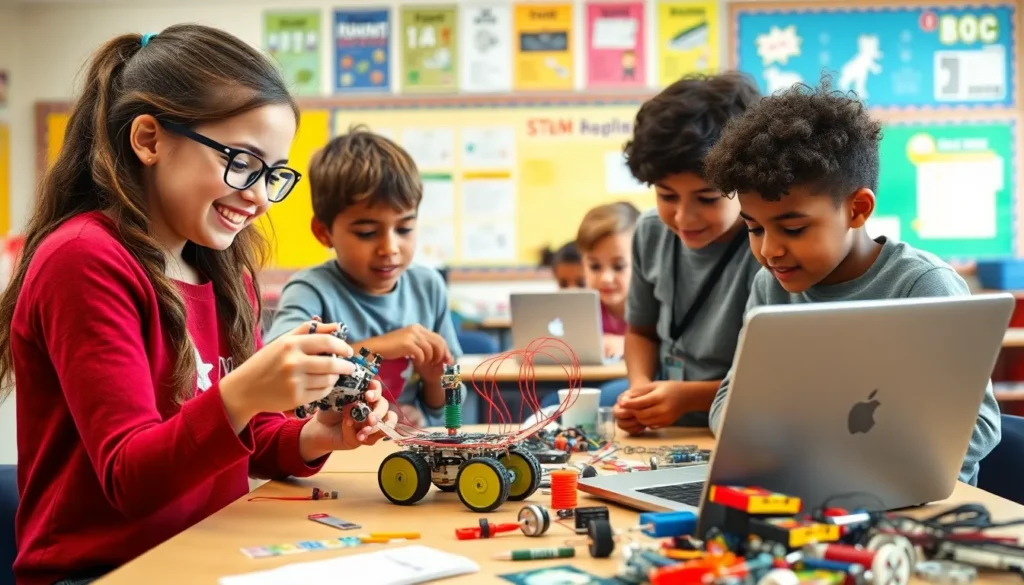Table of Contents
ToggleIn today’s tech-driven world, STEM education isn’t just a buzzword; it’s the golden ticket to a future filled with innovation and opportunity. Imagine a world where kids don’t just play video games but learn to create them. That’s the magic of STEM—science, technology, engineering, and math come together to spark curiosity and creativity.
Overview of STEM Education
STEM education plays a critical role in preparing students for a rapidly changing world. This educational approach integrates science, technology, engineering, and mathematics to create a comprehensive learning experience.
Definition of STEM Education
STEM education combines four key disciplines: science, technology, engineering, and mathematics. Each field contributes unique skills and knowledge relevant to real-world applications. Science encourages inquiry and experimentation, while technology provides tools for problem-solving. Engineering focuses on design and optimization, and mathematics offers quantitative analysis and reasoning skills. This integrated approach fosters a holistic understanding of concepts and promotes collaborative learning.
Importance of STEM Education
STEM education holds significant importance for future career pathways. It nurtures critical thinking, creativity, and problem-solving abilities essential in today’s workforce. As industries increasingly rely on technology, skills obtained from STEM education become vital. Employment data shows that STEM-related jobs have higher growth rates compared to non-STEM positions, reinforcing the necessity for a skilled workforce. Furthermore, engaging in STEM activities inspires innovation and supports economic development, while also preparing students for challenges in a global marketplace.
Benefits of STEM Education


STEM education provides a range of advantages vital for students’ development and future success. Engaging in STEM subjects fosters essential skills beneficial in everyday situations.
Enhancing Problem-Solving Skills
Students gain robust problem-solving skills through hands-on activities. Engaging in real-life scenarios motivates learners to look for solutions. Challenging problems enable students to analyze information critically and develop multiple approaches. Encouraged collaboration among peers fosters teamwork while tackling complex tasks. Experiencing various problem-solving methods leads to greater resilience and adaptability when faced with obstacles.
Encouraging Critical Thinking
Critical thinking abilities flourish in STEM education environments. Exposure to scientific methods prompts students to question assumptions and explore alternatives. Hands-on experiments require a thoughtful analysis of results and outcomes, reinforcing the importance of evidence in decision-making. Engaging with technology often challenges students to consider various perspectives, further deepening their analytical skills. Instilling a habit of inquiry leads to lifelong learning and active participation in their education.
Implementing STEM Education in Schools
STEM education implementation requires a focused approach to curriculum and training for educators. Effective integration fosters a robust educational environment.
Curriculum Development
Curriculum development plays a pivotal role in STEM education. It emphasizes hands-on learning experiences that stimulate curiosity. Schools can design multidisciplinary units combining science, technology, engineering, and mathematics, focusing on real-world problems. Lessons centered around collaborative projects encourage teamwork and critical thinking. Integrating technology into the curriculum enhances engagement, allowing students to explore and experiment. Assessments should align with these practical experiences, promoting skill application over rote memorization.
Teacher Training and Resources
Teacher training ensures educators effectively deliver STEM instruction. Professional development programs must equip teachers with current strategies and tools tailored for STEM disciplines. Workshops, online courses, and collaborative networks provide necessary resources for continuous learning. Mentoring opportunities connect experienced educators with newcomers, fostering skill-sharing. Schools should also invest in technology and manipulatives, enhancing classroom experiences. Access to industry partnerships can further enrich learning, connecting students with real-world applications in STEM fields.
Challenges in STEM Education
STEM education encounters various challenges that need addressing to maximize its impact on students. Funding shortages and limited resources hinder effective program implementation and development.
Funding and Resources
Insufficient funding affects the availability of materials, equipment, and technology essential for STEM programs. Many schools struggle to afford lab supplies, learning tools, and up-to-date technology. Limited budgets often result in outdated curricula, affecting the relevance of lessons. Partnerships with industry can provide external funding sources, yet many schools lack the connections to establish these collaborations. Additionally, adequate funding plays a critical role in supporting teacher training and professional development. Access to grants and community resources can enhance STEM initiatives, ensuring programs evolve to meet the growing demands of the job market.
Student Engagement
Student engagement in STEM remains a challenge, with many learners showing disinterest or lack of motivation. Traditional teaching methods often fail to inspire curiosity and critical thinking. Innovative practices like hands-on projects and collaborative learning significantly increase student interest. When lessons incorporate real-world applications, students become more invested in their education. Teachers must create dynamic learning environments that promote exploration and inquiry. Moreover, incorporating diverse perspectives and cultural relevance can capture students’ attention, making STEM subjects more relatable and appealing. Engaging students through interactive experiences fosters a deeper understanding of concepts and their applications in everyday life.
Future of STEM Education
STEM education continues shaping the landscape of learning and employment. Trends and innovations in this field play a crucial role in enhancing the educational experience.
Trends and Innovations
Adaptive learning technologies personalize the learning journey for each student. Project-based learning encourages students to solve real-world problems collaboratively. Online platforms provide access to a wealth of resources that extend beyond traditional textbooks. Virtual and augmented reality experiences immerse students in interactive environments, enhancing their understanding of complex concepts. As a result, these innovations foster greater engagement and interest in STEM subjects, motivating learners to explore further.
Preparing for a Technology-Driven World
Integrating coding and robotics into curricula prepares students for the future workforce. Emphasis on critical thinking and problem-solving cultivates essential skills for navigating complex challenges. Collaboration with industry partners provides insights into emerging technologies, keeping education relevant and aligned with market demands. Communicating and networking within STEM communities helps students build connections that support their career aspirations. Continuous focus on STEM education ensures individuals are equipped to thrive in a rapidly evolving, technology-driven world.
STEM education stands as a cornerstone for future success in an increasingly complex world. By nurturing critical skills like problem-solving and creativity, it prepares students to tackle real-world challenges head-on. The integration of hands-on learning experiences and collaborative projects fosters an environment where curiosity thrives.
As technology continues to evolve, the need for a skilled workforce in STEM fields becomes more pressing. Investing in effective teacher training and innovative curricula is crucial for sustaining student engagement and ensuring relevance in education.
Ultimately, prioritizing STEM education not only benefits individuals but also contributes to broader economic growth and innovation. Embracing this educational approach is essential for building a brighter future for all.







